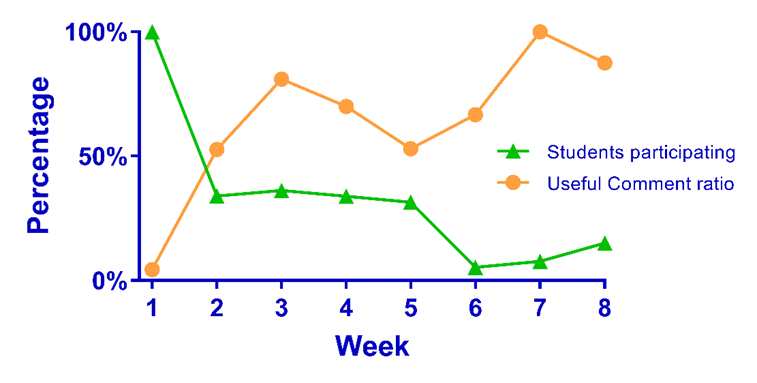Backchannel as a tool to provide opportunities for interactivity and engagement within the university classroom
Student interaction and engagement with peers and academics are important aspects of university learning. As universities heighten the use of technology in teaching, a rethinking of opportunities for student interaction and engagement is necessary. Today’s students widely communicate through social media, which has allowed them to become increasingly comfortable when discussing concepts over this space, including complex topics. This paper presents a brief overview of how Backchannels can be used in university classes. The authors also share the results of an investigation into the use of backchannel in their classrooms. This case study highlights some of the unique advantages and disadvantages to incorporating this channel of communication in the classroom.
What are Backchannels and How are they Used in University Classrooms?
Backchannel is a process whereby students are able to communicate with the lecturer while the front channel, the main presentation, is ongoing. In the past, feedback to the lecturer came through the students nodding their heads, or providing “mm-hmh’s” [1], whereas modern technology has allowed students to communicate in a far more interactive manner, and in real time. In this scenario, Backchannel involves students using networked computers and smartphones to provide textual questions, comments, feedback or anecdotes live, for the instructor to read and respond where appropriate. Student-to-student communicate is also enabled, with students, for example, commenting about relevance and application within their own lives, and applauding or debating, or countering specific points. This can be achieved via many applications that allow live-commenting, such as through learning management systems, blogs, forums, websites, or even social media such as Twitter.
Traditionally, students are usually able to ask questions in class, although this involves waiting for the instructor’s acknowledgement, and subsequently stopping the class in order to ask a question and receive the immediate answer. In contrast, Backchannel allows the same question to be asked, and be read by the instructor immediately, and then it isthe instructor’s choice of whether to answer immediately or weave the answer into the subsequent session content. Other students can also read the backchannel, and answer each other’s questions if possible. This converts the “whispers” heard throughout classes, between students, into real-time live discussions, all monitored by the instructor, while the session is in process.
Supporting Student Diversity
A unique advantage to Backchannel is that it provides students who would otherwise hesitate to contribute to discussion, the opportunity to ask, and answer, questions in real time. In this respect, Backchannel encourages interaction on the part of those students who are perhaps shy or more introverted or who are apprehensive about their ability to speak in the language of instruction. . Backchannel also bridges the gap in many modern university classrooms, where older and more confident students are integrated with younger counterparts in the same subjects. For example, in medicine, traditionally postgraduate courses are being offered as undergraduate options, effectively creating divides between more experienced postgraduate students, and their undergraduate counterparts within the same subjects [2].
Of course, in all classes where backchannel is provided, traditional learning still takes place, and students can always ask and answer questions aloud. Backchannel provides a second, distinct, channel of communication within a class environment. In universities, face-to-face teaching is increasingly being supplemented with, or replaced by, digital content, such as online courses, applications or modern technology-enhanced options for learning [3]. In this context, it seems particularly important to maximise the engagement of all students when on-campus or in the presence of a live instructor. Toward this end, Backchannel opens new lines of communication, classroom interactivity and provides opportunities for participation to all attendees, even in a diverse classroom.
Lessons from Practical Use
Between 2013 and2016, backchannel software was implemented in a first-semester health science course to provide students with a direct method to communicate to one another and the lecturer. Student perceptions of the technology, lecture interaction and the overall benefits to students’ content acquisition were analysed.
Results revealed that throughout each semester students became increasingly comfortable with using the backchannel software. Rates of participation demonstrably increased when the online backchannel interactions enabled anonymous comment. Anonymity maximised the use and impact of this technology in that it further minimised any reluctance to participate; however, it also allowed for a wide range of immature and silly comments to be posted during the lecture. Such comments clearly did not contribute to the overall learning objectives and could be distracting to others (Table 1).
In summary, there were 13-18 comments in each class, with enrolments of approximately fifty students. Of these comments, 72 per cent were classified as useful (ie: questions, comments about the class, answers). There were on average, 9 highly useful comments per class, and these usually generated discussions immediately in the lesson, or at the start of the subsequent lesson. In Week 1, every student participated in the backchannel, although this was usually to say “hello” or provide a silly comment, meaning that although this week had 100% of students involved, only 3-4% of the comments provided were useful (Figure 1). However, once the students started to get the novelty effect out of their system, by week 2, although less students provided comments, those received were more useful. As the semester progressed, it seemed that only students who had valid comments utilised the backchannel system, meaning that by Week 7, nearly 100% of comments received were useful, generating responses or clarifications from the instructor (Figure 1).
In practice, the benefits of the increased interactivity outweighed the negatives. Backchannel encouraged a heightened level of questioning, engagement and interaction within the lecture context. Although the comments were not necessarily better than if the student had simply volunteered to speak, the increased number of interactions demonstrated that normally more reserved or timid students were able to submit their questions without fear of speaking in front of the cohort. In this respect, backchannel presents a prime example of how technology can enhance the traditional lecture-style format and stimulate effective and interactive class participation.
Table 1: The first 20 comments provided through the Backchannel in a Semester One Physiology lecture during the second week of the course. The comments have been separated into “useful” or “silly” depending on their content. All comments were provided by different students.
| “Useful” Comments | “Silly” Comments |
| So, passive transport requires no energy? | Hi |
| So does the same amount of Na+ that rushes out, come in as well? | Hello |
| What is the name of the vestibule used in phagocytosis? | Hello World |
| Can you make two macrophages recognise each other as antigens? | :3 |
| Does the cell purposely pump Na out to allow glucose in? | Much fluidic, such doge |
| What is vesicular trafficking? | Can we have a break now? |
| What exactly does permeability mean? | Nice tie |
| What is the difference between polarity and cell basement? | Is this working? |
| Can cuboidal cells be pseudostratified? | Did someone say lads? |
| Why are stratified squamous cells in the mouth? | Break? |
 Figure 1: The percentage of students within the class who provided comments, and the ratio of those comments to useful comments.
Figure 1: The percentage of students within the class who provided comments, and the ratio of those comments to useful comments.
Reflections, practical strategies, and suggestions for implementation of backchannel software
- Backchannel works well in certain circumstances, and the negatives of high levels of useless comments in the first 2 weeks of use, are outweighed by the higher ratio if useful comments per participant in the later weeks.
- Backchannel is particularly effective in first semester classes, where students are new to the university environment (in other tracked classes, participation rates of only 4-8% occurred from students in later semesters).
- Backchannel is the most effective within the first five weeks of a class’ commencement, with particularly high participation and quality comments presented in weeks two and three.
- After week three, participation diminished, although the content provided was generally useful
- Backchannel use does not seem to be as distracting to the class as initially expected
- The authors refined their practice, in that in later offerings, they did not have the backchannel shown on the lecture screen at all times. Instead, reveal the backchannel screen intermittently, or keep it on a separate tablet or computer at the front desk.
- Linking comments to the start of subsequent weeks, and to tutorials, works very well! Refer back to some of the common questions or comments made on the backchannel at the start of the subsequent lesson.
- Anonymous student responses appears to work best, although this induces a higher ratio of ‘silly’ comments from students.
References:
- Yngve, V. (1970). On getting a word in edgewise. In M. A. Campbell (Ed.), Papers from the Sixth Regional Meeting of the Chicago Linguistic Society, (567-578). Chicago, IL: Chicago Linguistic Society
- Moro, C. and McLean, M., Supporting Students’ Transition to University and Problem-Based Learning. Medical Science Educator, 2017: p. 1-9. doi:10.1007/s40670-017-0384-6
- Moro, C., Štromberga, Z., Raikos, A. and Stirling, A. (2017), The effectiveness of virtual and augmented reality in health sciences and medical anatomy. Anatomical Sciences Education. doi:10.1002/ase.1696

Christian Moro

Latest posts by Christian Moro (see all)
- Engaging Timid Students - June 15, 2018
You must be logged in to post a comment.


There are no comments
Add yours